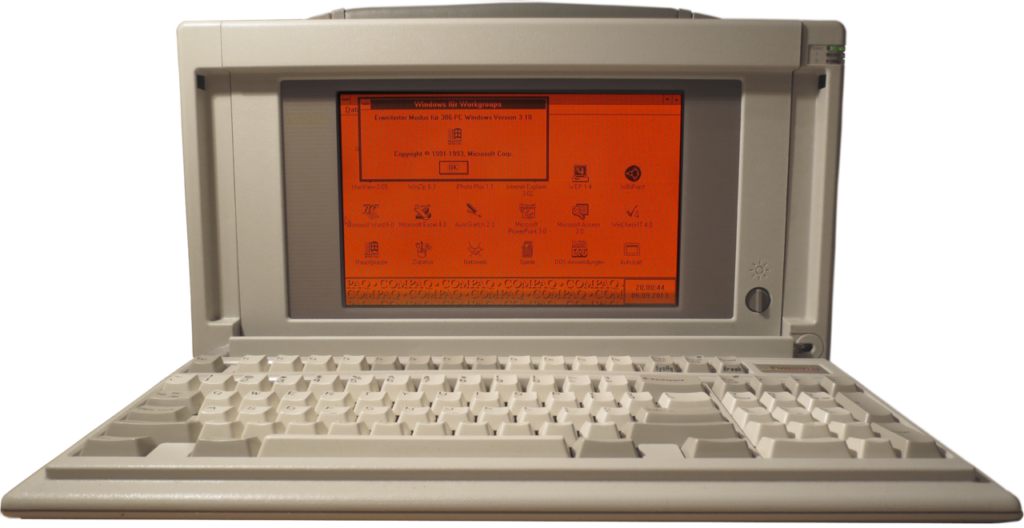Posted on July 2, 2021
Compaq Portable III (286, Model 40)
Up until around the mid 1980s, the typical “portable” computer was literally a desktop-style case with a carrying handle. The Compaq Portable III marks a turning point, introducing a more compact format and reduced weight.
Quick Links:
Historic Overview
We’re still a while until we see more compact laptops appearing in quantities. Meanwhile, the Compaq Portable III left a hefty impression.

It’s 1987, when the Portable III hits the market: A PC/AT clone at it’s heart, sporting a 12 MHz Intel 80286 CPU and 640 KiB of RAM, a 1.2 MiB 5.25″ floppy drive, and optional 20 and 40 MiB harddrive options, this machine was ready to shake things up.
Up until now, portable machines mostly were, simplistically saying, just ordinary desktop-style cases, that got a CRT screen fitted into, with an added carrying handle stuck onto it. These were often referred to luggable computers.
The Portable III marks a turning point. On one side, it brings in a more compact footprint and reduced weight of only around 9.1 kilogramms. Still a heavy-weight, but doing away with the CRT, replacing it with a 10″ gas-plasma display instead, combined with the 80286 and the harddrive option, the Portable III set a tone for mobile computing performance.
On the other side, the Portable III (and the Portable 386) would be one of the last luggables to be produced. Having had traditional desktop technology in portables before, would allow easy swapping of most if not all components vice-versa. This is something, that was starting to change with this machine generation. While still using standard drives and cables, as seen in desktops up until now, the Portable already sported a very specific, non-AT-style form-factor mainboard, bringing along some proprietary internal connectors for expansion modules, such as the modem, or memory upgrades. This is a tendency, that would continue in later years with literally all vendors and mobile machines.
Admittedly, there also had been more leightweight and compact systems, sporting LCD technology and resembling the modern laptop style, in the years just before the Portable III, some examples being:
- Data General One (1984, ~3.6 KG)
- HP 110/100 Plus (1984, ~3.6 KG)
- Kaypro 2000 (1985, laptop style, 5.4 KG)
- IBM PC Convertible from 1986 (~5.5 KG)
However, none of them brought in the Intel 80286, lest to say in combination with harddrives. And it would not be long that the Portable III saw the introduction of the Intel 80386 CPU, getting renamed to Portable 386 as a consequence.
Specs
The PHINTAGE Collection currently holds a Compaq Portable III, 286/Model 40.
| Vendor | Compaq |
| Model | Portable III, 286/Model 40 |
| Released | 1987 |
| Original Streetprice | – 3999 USD for the base model (no HDD) – 4999 USD for the Model 20 (20 MiB HDD) – 5799 USD for the Model 40 (40 MiB HDD) – 199 USD for the optional backside expansion case |
| Weight | ~9.1 KG |
| Dimensions | 41cm x 19.2cm x 24.8cm |
| Builtin Display | YES, Gas-Plasma, 10″, CGA 640×400 (2 colors) |
| Builtin Battery | NO (A/C power one) |
| CPU | Intel 80286, 12 MHz |
| RAM | 640 KiB |
| Storage | – Originally a Connor ATA 40 MiB HDD (defunct) – replaced by 32 MiB CF (via CF2IDE Adapter) – 3.5″ 1.2 MB high-density floppy drive |
| Network Support | optional (via ISA adapter, through optional expansion case) |
| USB | n/a |
| Video Output | Standard VGA Connector |
| Other | 1 parallel port, 1 RS232 serial port |
| Operating System | Compaq MS-DOS 3.31 Windows 2.03 |
| Overall Condition | – Very good condition, no scuffs or markings – Keyboard cable shell is disintegration – Plasma Display has minor distortion lines on the left-hand side |
| Restoration Parts needed | – Replacement keyboard cable – Replacement Plasma Display – Expansion Case |
| Benchmark Results | SiSoft Sandra 99, CPU benchmark: n/a SiSoft Sandra 99, Multimedia benchmark: n/a Norton Utilities 3.1: Computing Intex, relative to IBM/PC: 11.5 Norton Utilities 4.5: Computing Index, relative to IBM/XT: 11.5 Norton Utilies 8.0: CPU Speed: 6.5 |
Gallery
Coming soon.
Downloads
Coming soon.
